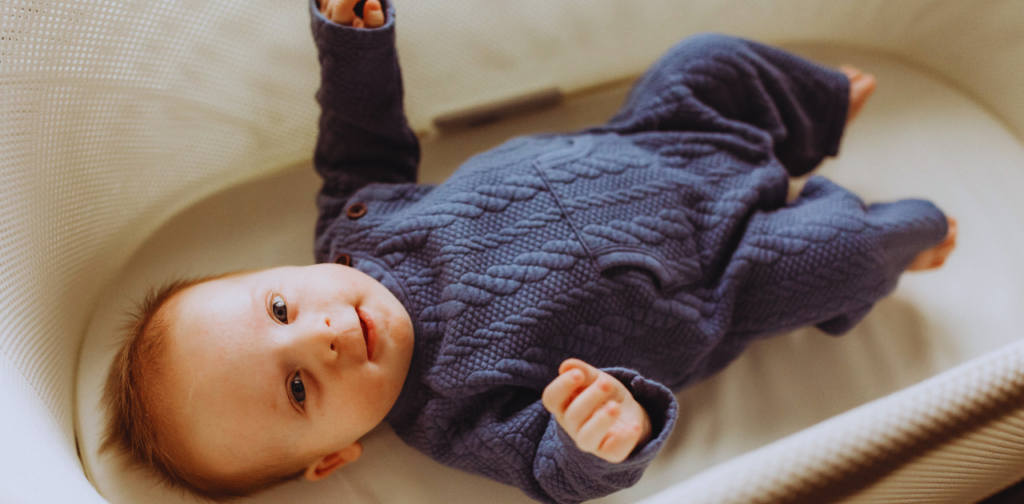Getting your baby to sleep in a bassinet can be a daunting task, but it’s essential for their safety and your peace of mind. Babies have unique sleep patterns and specific needs, so creating the right environment and establishing a consistent routine is crucial. From understanding your baby’s sleep cues to choosing the perfect bassinet, several strategies can help. Whether you’re dealing with a fussy newborn or a baby who won’t settle. And with these tips will guide you towards restful nights for you and your little one.
Let’s explore how to get the baby to sleep in a bassinet. You can ensure your baby sleeps soundly and safely in their bassinet with patience, persistence, and the right approach.
Importance of Safe Sleep for Babies
Safe sleep practices for babies are crucial in reducing the risk of Sudden Infant Death Syndrome (SIDS) and other sleep-related incidents. Ensuring your baby sleeps in a safe environment is one of the most important steps you can take as a parent. Safe sleep guidelines recommend that babies be placed on their backs to sleep on a firm, flat sleep surface free of soft bedding, pillows, or toys. An appropriately sized bassinet can provide your baby a secure and comfortable space, promoting better sleep quality and reducing the chances of suffocation or overheating.

Maintaining a consistent sleep routine and monitoring the sleep environment can significantly enhance your baby’s safety. Keeping the Room at a moderate temperature and using a sleep sack instead of loose blankets can prevent overheating and reduce SIDS risk. Understanding and implementing these safe sleep practices protects and offers peace, allowing you to rest easier knowing your little one is sleeping safely. By prioritizing safe sleep, you’re fostering healthy sleep habits that will benefit your baby as they grow.
Common Challenges Faced by Parents
Parents often encounter several challenges when getting their baby to sleep in a bassinet. One common issue is the baby’s resistance to sleeping on their back, as recommended for safe sleep. Babies may find this position unfamiliar or uncomfortable, leading to fussiness and frequent waking. Another challenge is establishing a consistent sleep routine. Newborns have irregular sleep patterns and may wake up frequently for feedings, making it difficult for parents to set a predictable schedule.
Some babies struggle to transition from being held to sleeping independently in a bassinet. They may cry or become distressed when placed in the bassinet, leading to frustration for both the baby and parents. Environmental factors such as room temperature, noise, and lighting can also impact a baby’s ability to sleep soundly in a bassinet. Parents might struggle to create the perfect sleep environment for their baby’s needs.
Understanding Baby Sleep Patterns
Understanding your baby’s sleep patterns is crucial for helping them sleep soundly in a bassinet. Babies have unique sleep needs that differ significantly from adults. Knowing how these patterns work can help you create a better sleep environment and routine for your little one.
Newborn Sleep Cycles
Newborns have shorter sleep cycles than adults, typically lasting 50-60 minutes. During this time, they transition through different stages of sleep, including light sleep (REM) and deep sleep (non-REM). REM sleep is lighter and more active, often marked by movements, smiles, and occasional crying out. This is when the brain is highly active, processing and developing.
In contrast, non-REM sleep is deeper and more vital. Newborns spend more time in REM sleep so that they might wake up more frequently. Understanding this cycle helps explain why newborns often wake up every couple of hours and must be soothed back to sleep. As they grow, their sleep cycles lengthen, and they spend more time in deep sleep.
Recognizing Sleep Cues
Recognizing your baby’s sleep cues can help you put them to bed at the right time and avoid overtiredness. Familiar sleep cues include rubbing eyes, yawning, becoming fussy, and losing interest in play. Some babies may also exhibit subtle signs like quieting down, staring off, or pulling at their ears.
Acting promptly when you notice these cues can make the process smoother. If you wait too long, your baby might become overtired, making it harder for them to settle down and fall asleep. By catching these early signals, you can help your baby transition to sleep more quickly and develop a healthy sleep routine. Understanding and responding to these cues is critical to fostering good sleep habits and ensuring your baby feels secure and comfortable in their bassinet.
Is It Okay to Let My Baby Cry It Out in the Bassinet?

The “cry it out” method, also known as controlled crying, can be a contentious topic among parents. This approach involves letting your baby cry for a predetermined amount of time before offering comfort and is typically considered for babies aged 4-6 months and older. Using this method in the bassinet is acceptable for some families, provided it aligns with your baby’s needs and your comfort level.
A gradual approach, letting your baby cry for increasing intervals while periodically checking on them, can help your baby learn to self-soothe. Consistency is critical to avoiding confusion and ensuring the method’s effectiveness. While some research indicates that babies can develop better sleep habits through this method, concerns about emotional impact exist. If the technique feels too stressful, consider gentler alternatives, such as gradually reducing your involvement in your baby’s sleep routine. Ultimately, deciding to use the cry-out method in the bassinet depends on what works best for your family and your baby’s well-being.
Sleeping baby in the bassinet
Ensuring your baby sleeps comfortably in the bassinet is essential for their safety and your peace of mind. Start by selecting a bassinet that meets safety standards and offers a firm, flat sleeping surface. Remove any soft bedding, pillows, or toys that could pose a suffocation hazard. Create a soothing sleep environment by keeping the room dark, quiet, and at a comfortable temperature.

Consider using white noise or gentle music to help your baby relax. Establish a consistent bedtime routine to signal your baby that it’s time to sleep. This might include a warm bath, a gentle massage, and a bedtime story. Swaddling can also provide a sense of security and comfort for your baby. Place your baby on their back to sleep and ensure they are not overdressed or too hot. Be patient and persistent, as it may take time for your baby to adjust to sleeping in the bassinet. You can help your baby sleep soundly and safely in their bassinet with the right approach and patience.
Is it safe to use a bassinet for overnight sleep?
Yes, using a bassinet for overnight sleep is safe as long as it meets safety standards and guidelines. Bassinets are designed for newborns and infants, providing a secure and comfortable sleeping environment. It’s essential to ensure the bassinet is set up correctly, with a firm mattress, fitted sheet, and no loose bedding or pillows. Additionally, always place your baby on their back to sleep to reduce the risk of Sudden Infant Death Syndrome (SIDS). By following these safety precautions, a bassinet can be a safe and convenient option for overnight sleep for your baby.
Common ways to get a baby to sleep in a bassinet
To get your baby to sleep in the bassinet, follow these steps:
- Choose the Right Bassinet: Select one that meets safety standards and offers a firm, flat sleeping surface.
- Create a Comfortable Sleep Environment: Remove loose bedding or toys from the bassinet to reduce the risk of suffocation. Keep the Room dark, quiet, and at a comfortable temperature.
- Establish a Bedtime Routine: Develop a consistent bedtime routine to signal your baby that it’s time to sleep. This could include a warm bath, gentle massage, and soothing lullabies.
- Swaddle Your Baby: Swaddling can provide security and help your baby feel more comfortable in the bassinet.
- Place Your Baby on Their Back: Always place your baby on their back to sleep to reduce the risk of Sudden Infant Death Syndrome (SIDS).
- Use White Noise or Gentle Music: Playing white noise or soft music can help drown out background noises and soothe your baby to sleep.
- Comfort and Reassure Your Baby: If your baby becomes fussy or restless, comfort them with gentle words and soothing touches. Avoid picking them up unless necessary to help them learn to self-soothe.
- Be Patient and Persistent: It may take time for your baby to adjust to sleeping in the bassinet. Stay consistent with your bedtime routine and be patient as your baby settles into their new sleeping environment.
How to Choose the Right Bassinet?
To choose the suitable bassinet for your baby, consider the following factors:
- Safety Standards: Ensure the bassinet meets current safety standards, including sturdy construction, a firm mattress, and breathable sides to reduce the risk of suffocation.
- Size and Portability: Choose a bassinet that fits comfortably in your bedroom or nursery and is easy to move around if needed.
- Adjustable Height: Look for a bassinet with adjustable height settings, allowing you to match the height of your bed for convenient nighttime feedings.
- Comfort Features: Opt for a bassinet with features that enhance your baby’s comfort, such as a cosy mattress pad, soft bedding, and a gentle rocking or swaying motion.
- Storage Space: Consider bassinets with storage baskets or pockets for keeping essential items like diapers, wipes, and pacifiers within reach.
- Durability and Quality: Invest in a well-made bassinet that will withstand daily use and provide a safe sleeping environment for your baby.
- Ease of Cleaning: Choose a bassinet with removable and washable fabric covers or mattress pads for easy cleaning and maintenance.
- Budget: Set a budget and compare different bassinet options within your price range, considering quality and features.
Top 7 Ways to get Your Newborn to sleep in a bassinet
Swaddle Your Baby: Wrap your newborn snugly in a swaddle blanket to mimic the feeling of being in the womb, promoting comfort and security in the bassinet.
Establish a Bedtime Routine: Create a consistent bedtime routine with calming activities like a warm bath and gentle massage to signal your newborn that it’s time to sleep.
Use White Noise or Gentle Music: Play white or soft music to create a soothing environment and mask background noises that could disturb your newborn’s sleep in the bassinet.
Keep the Room Dark and Quiet: Ensure the sleep environment is conducive to rest by keeping the Room dark with blackout curtains and minimizing noise disturbances during nighttime sleep.
Offer Comfort and Reassurance: Provide gentle comfort and reassurance to your newborn if they become fussy or restless in the bassinet, using soft touches and soothing motions to help them settle.
Place Your Newborn on Their Back to Sleep: Always place your newborn on their back to sleep to reduce the risk of Sudden Infant Death Syndrome (SIDS) and ensure safe sleep practices in the bassinet.
Stay Consistent and Patient: Be consistent with your sleep routines as your newborn adjusts to sleeping in the bassinet, knowing that it may take time to feel comfortable and secure in their new sleeping space.
What if My Baby Refuses to Sleep in the Bassinet?

If your baby refuses to sleep in the bassinet, don’t worry—this is a common issue with several potential solutions:
- Create a Consistent Bedtime Routine: Establishing a predictable bedtime routine can signal your baby that it’s time to sleep. This routine might include a warm bath, a gentle massage, a quiet lullaby, and placing your baby in the bassinet. Consistency helps your baby understand what to expect and feel secure.
- Make the Bassinet Comfortable and Familiar: Try using a swaddle or sleep sack to keep your baby cosy. You can also place a worn piece of your clothing near the bassinet (but not inside) so your baby can smell your scent, which can be comforting.
- Ensure a Safe and Soothing Sleep Environment: Keep the Room dark and quiet, or use a white noise machine to block out background noises. Ensure the Room is comfortable to help your baby sleep better.
- Try Gradual Transition: If your baby is used to sleeping in your arms, try gradually transitioning them to the bassinet. Start by placing them in the bassinet while drowsy but not fully asleep so they learn to associate it with sleep.
- Address Any Discomfort: Make sure your baby isn’t hungry, has a clean diaper, and is free from discomforts like gas or reflux. Addressing these issues can sometimes help them settle into the bassinet more easily.
Alternative Ways To Help Your Newborn Sleep
Here are some alternative ways to help your newborn sleep:
- Babywearing: Use a baby carrier or wrap to keep your newborn close to you during naps. The gentle motion and closeness can soothe your baby to sleep.
- Co-sleeping: Consider safely co-sleeping with your newborn in the same bed or using a bedside bassinet to keep them close at night. This can make nighttime feedings more accessible and promote bonding.
- Rocking or Swaying: Rocking your newborn in your arms or using a rocking chair or bassinet can help calm them and encourage sleep.
- Infant Swing or Rocker: A gentle swing or rocker can mimic the sensation of being rocked in your arms and help lull your newborn to sleep.
- Baby Massage: A gentle massage before bedtime can relax your newborn’s muscles and promote relaxation, making it easier for them to fall asleep.
- Warm Bath: A warm bath before bed can help soothe your newborn and signal that it’s time to wind down for sleep.
- Pacifier Use: Offering a pacifier can provide comfort and help satisfy your newborn’s natural sucking reflex, making it easier for them to settle and fall asleep.
- Baby Hammock: Some parents find success using a baby hammock or suspended bassinet, which provides a gentle rocking motion to help soothe your newborn’s sleep.
- Swing or Bouncer: A gentle swing or bouncer can offer a soothing motion that helps calm your newborn and promote sleep
FAQs (Frequently Asked Questions)
What if my newborn doesn’t like sleeping in the bassinet?
It’s common for newborns to adjust to sleeping in a bassinet. Try swaddling, establishing a bedtime routine, and offering comfort to help them feel more comfortable.
How often should I check on my newborn sleeping in the bassinet?
While monitoring your newborn is essential, frequent disruptions can interfere with their sleep. Check on them periodically or if you hear any unusual sounds or cries.
Can I use a bassinet for naps during the day?
Yes, bassinets are suitable for naps during the day. Place your newborn in the bassinet in a quiet, dimly lit room to promote restful sleep.
Can white noise be harmful to my baby?
When used at a moderate volume, white noise is safe and can be very helpful in promoting sleep.
What should I do if my baby wakes up frequently at night?
Ensure they are comfortable, not hungry, and have a consistent bedtime routine. If the problem persists, consult a pediatrician.
Conclusion
In conclusion, helping your newborn sleep in a bassinet requires patience, consistency, and a nurturing approach. By creating a calming sleep environment, establishing a bedtime routine, and offering comfort and reassurance, you can help your baby feel secure and comfortable in their bassinet. Remember to prioritize safety follow safe sleep practices, and be patient as your newborn adjusts to their new sleeping arrangements. With time and persistence, you’ll find a routine that works for you and your baby, promoting restful sleep.















